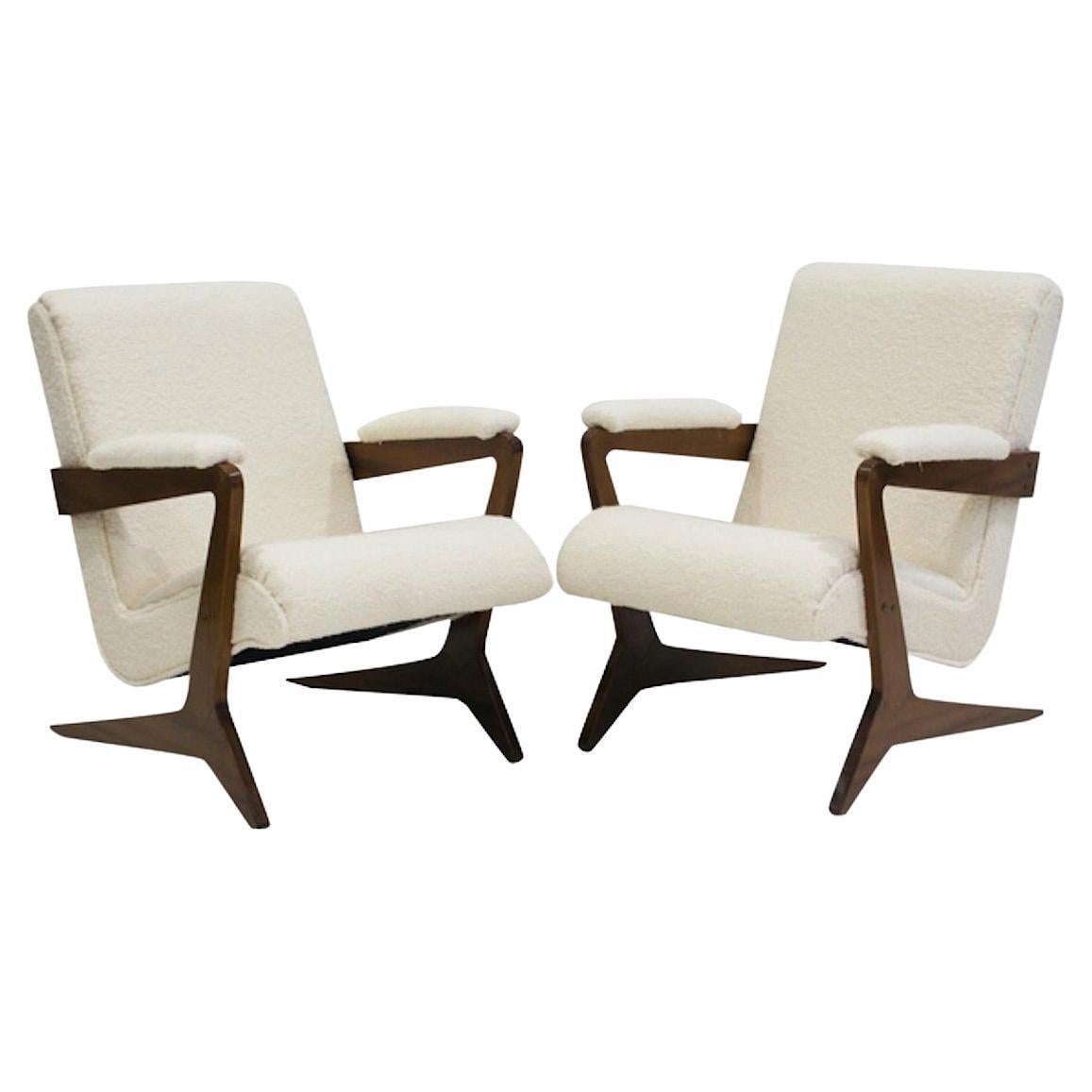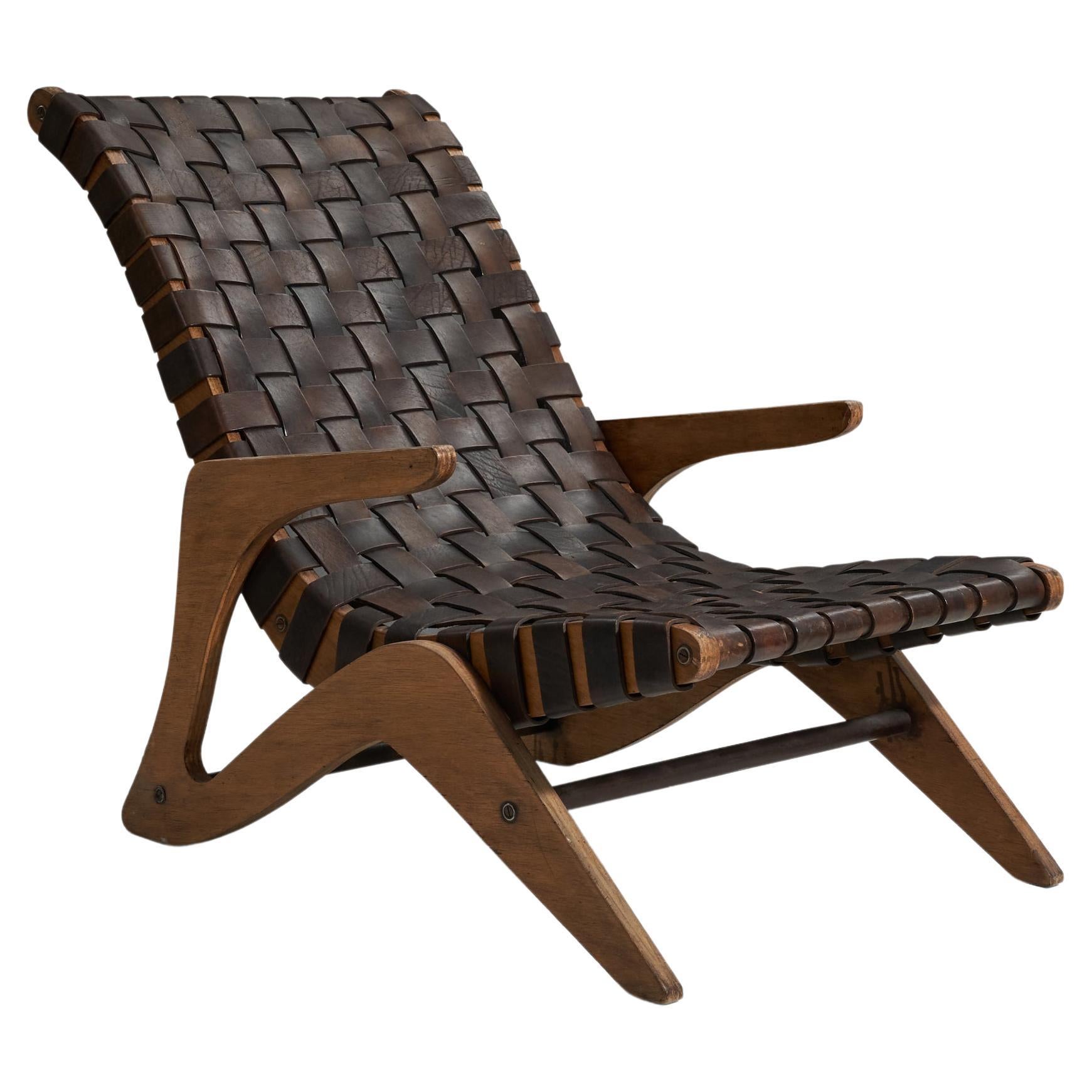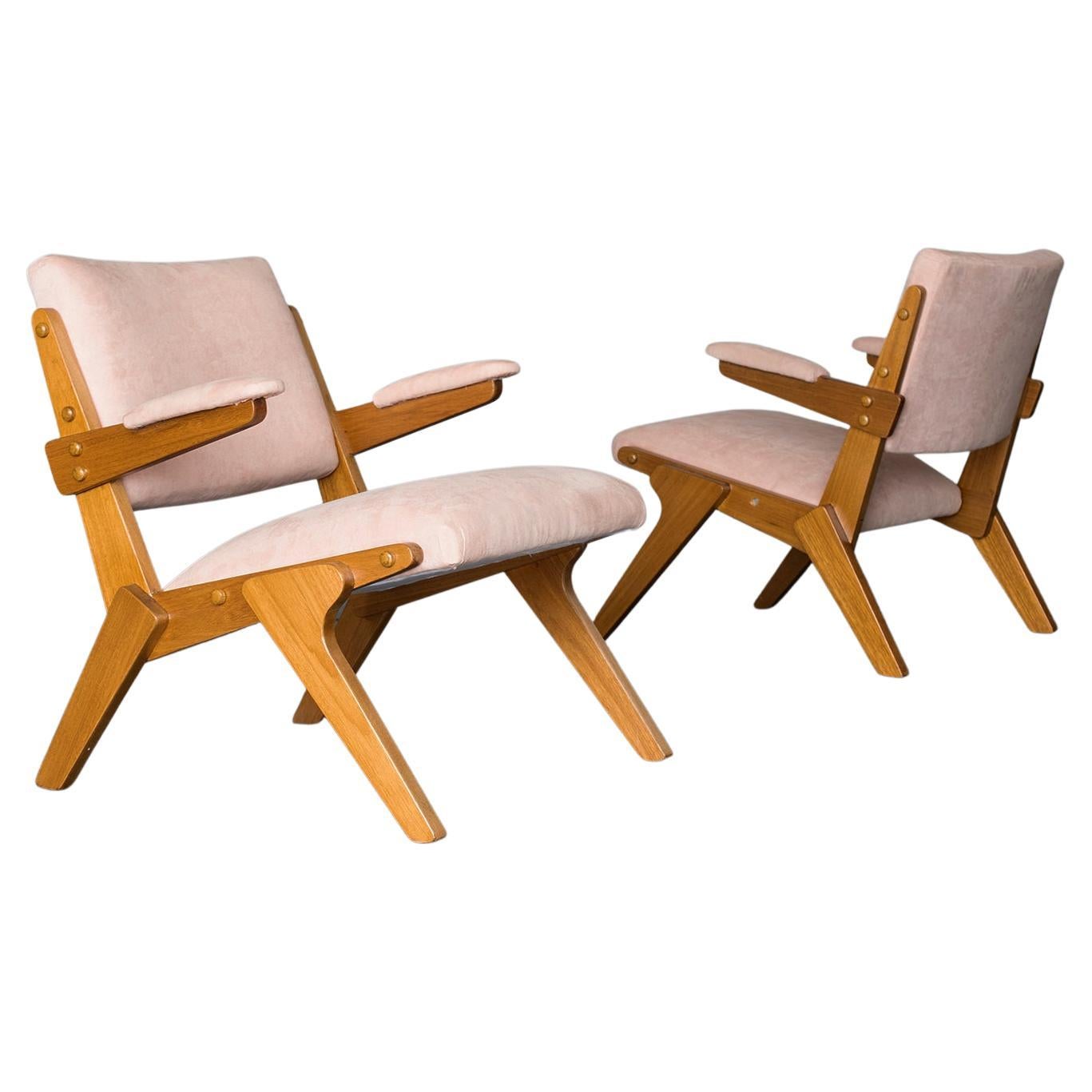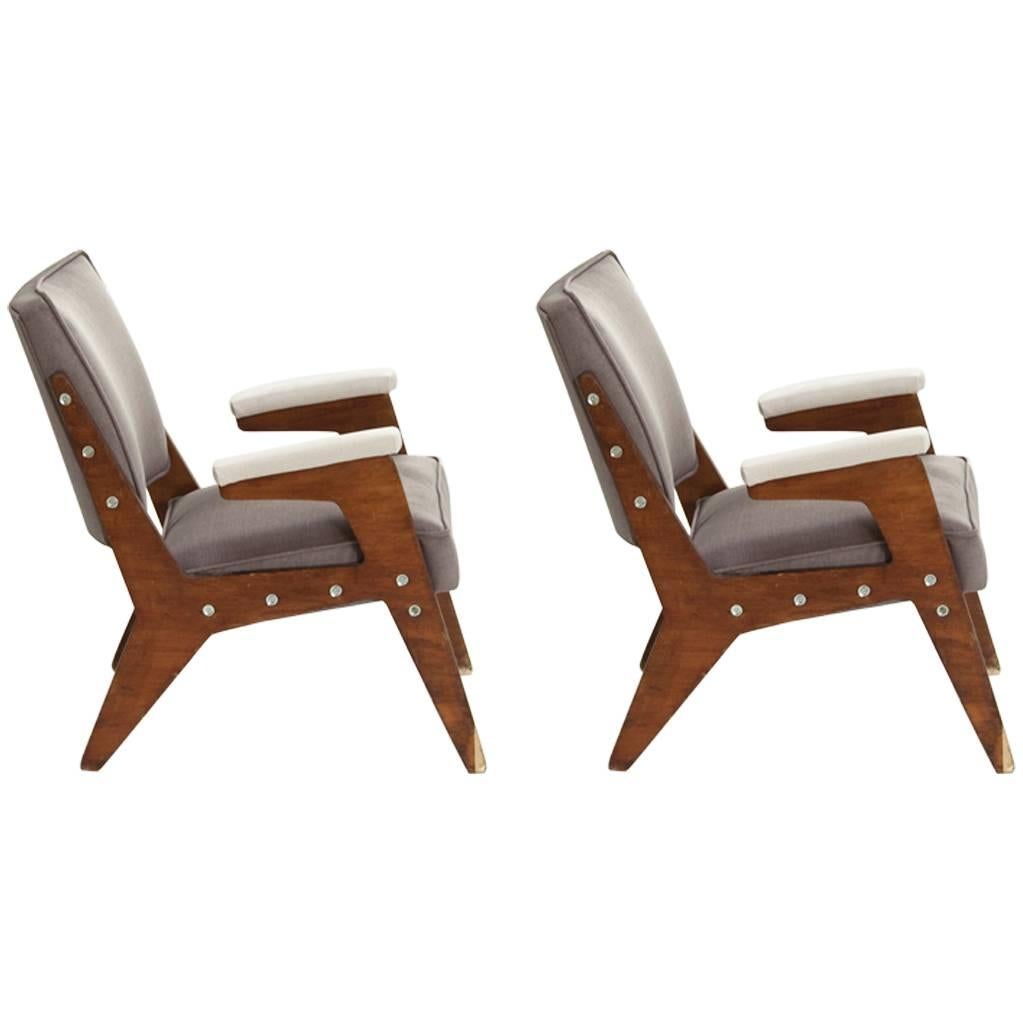Items Similar to José Zanine Caldas Attributed Pair of "Zeca" Lounge Chairs, Brazil, circa 1960
Want more images or videos?
Request additional images or videos from the seller
1 of 15
José Zanine Caldas Attributed Pair of "Zeca" Lounge Chairs, Brazil, circa 1960
About the Item
The “Zeca” armchair was designed by the pioneering Brazilian designer, Jose Zanine Caldas. Made of solid wood, this armchair was named after the childhood nickname of the designer.
Design attributed to Jose Zanine Caldas for Móveis Artísticas Z
Brazil, circa 1960
Size: 33 1/2" high x 16" seat height x 33" wide x 34" deep
Jose Zanine Caldas is often referred to as the “Master of Wood” for the promotion and integration of traditional Brazilian crafts and modernism in a unique way, which is very visible in this lounge chair. Designed in the early 1960's for Móveis Artísticas Z, a factory he founded in São José dos Campos in 1948, the “Zeca” chair brings some of the unmistakable marks of the work of the master of wood.
The beautiful plywood frame (Móveis Artísticas Z specialised in the material) has an organic shape, characterized by the distinctive curve of the armrests that extend into the legs. The design is complemented by the light upholstery in an Italian Dedar Milano cream/white bouclé fabric.
A self-taught artist, designer and architect, Jose Zanine Caldas (1919-2001) was born on the southern coast of Bahia in Brazil. At age twenty, he opened an architectural scale model workshop in Rio de Janeiro where he worked with modernist pioneers such as Lucio Costa and Oscar Niemeyer.
In 1948, he and two business partners started the company Mo´veis Artisticos Z. Their elegantly simple, organically-shaped pieces in plywood were produced at a price point that made them accessible to the emerging market of collectors with an eye toward a modern style.
In the early 1950's, Zanine left the company and returned to his home state of Bahia. Heavily inspired by the local craftsmen there who carved boats and furniture from felled trees, Zanine began experimenting with chiseling and carving large, sculptural works, which became the focus of his later career. He also set himself apart with his pavilion-type architectural constructions in richly-colored hewn logs. Zanine was a devoted steward of the forest and proponent of environmental protection. He wrote extensively about his connection to the forest and tried, whenever possible, to either use already felled trees or to plant a tree for each one he used.
Zanine’s work has been exhibited in the Musée des Arts Decoratifs in Paris and throughout his native Brazil. In 2015, it was included in Moderno: Design for Living in Brazil, Mexico and Venezuela 1940-1978, a traveling exhibition organized by the Americas Society. Zanine, who died in 2001, dubbed his creations “outcry furniture,” considering them a form of silent protest against the destruction of local rainforests..
- Attributed to:José Zanine Caldas (Designer)
- Dimensions:Height: 33.5 in (85.09 cm)Width: 33 in (83.82 cm)Depth: 34 in (86.36 cm)Seat Height: 16 in (40.64 cm)
- Style:Mid-Century Modern (Of the Period)
- Materials and Techniques:
- Place of Origin:
- Period:
- Date of Manufacture:1960
- Condition:Reupholstered. Refinished. Restored and re-upholstery in an Italian Dedar Milano Boucle in our professional studio.
- Seller Location:New York, NY
- Reference Number:1stDibs: LU1433232156272
About the Seller
5.0
Platinum Seller
These expertly vetted sellers are 1stDibs' most experienced sellers and are rated highest by our customers.
Established in 2015
1stDibs seller since 2015
163 sales on 1stDibs
Typical response time: <1 hour
- ShippingRetrieving quote...Ships From: Secaucus, NJ
- Return PolicyA return for this item may be initiated within 1 day of delivery.
More From This SellerView All
- Pair of Italian Sculptural Faux Shearling Lounge Chairs, Italy, circa 1960Located in New York, NYPair of Northern Italian sculptural armchairs, the arms elegantly splayed, the whole newly upholstered in a creamy white faux shearling, with chic black metal and brass tapered legs....Category
Vintage 1960s Italian Mid-Century Modern Lounge Chairs
MaterialsBrass
- Pair of Sculptural Italian Vintage Lounge Chairs, Attributed to Gio PontiBy Gio PontiLocated in New York, NYA very elegant pair of Italian vintage mid century modern lounge chairs; their highly sculptural shape is complemented by custom originally designed brass nail heads. Beautifully pro...Category
Vintage 1950s Italian Mid-Century Modern Lounge Chairs
MaterialsBrass
- Pair of Marco Zanuso for Arflex 'Senior' Lounge Chairs, Italy, circa 1951By Marco Zanuso, ArflexLocated in New York, NYA pair of the iconic 'Senior' lounge chairs, designed by Marco Zanuso and manufactured by Arflex, in Italy, 1951. This pair have been fully restored and newly upholstered in our prof...Category
Vintage 1950s Italian Mid-Century Modern Lounge Chairs
MaterialsFabric
- Pair of Adriano Piazzesi Italian 1970's Lounge ChairsBy Adriano PiazzesiLocated in New York, NYPair of Adriano Piazzesi Italian 1970's lounge chairs; the whole with channel and tufted upholstery, the sides and back are curved and covered in a warm brown Italian leather. The ch...Category
Vintage 1970s Italian Lounge Chairs
MaterialsLeather, Fabric, Wood
- Pair of Italian Modernist Iron Upholstered Armchairs, circa 1960Located in New York, NYA sleek and very unique pair of Italian modern armchairs, the iron frame supports a wide seat, back and extra wide armrest extending t...Category
Vintage 1960s Italian Mid-Century Modern Armchairs
MaterialsIron
- Paolo Buffa Pair of Lounge Chairs, Italy, circa 1950By Paolo BuffaLocated in New York, NYA pair of Paolo Buffa lounge chairs, designed in 1950 for the Hotel Bristol, Merano, an Italian resort. The chairs are indicative of Buffa's signature style, modernist and sleek but ...Category
Vintage 1950s Italian Mid-Century Modern Lounge Chairs
MaterialsFabric, Walnut
You May Also Like
- Pair of Zeca Armchairs by José Zanine CaldasBy Mòveis Artisticos Z, José Zanine CaldasLocated in Madrid, ESThe "Zeca" chair was created in the early 1960s by a Brazilian designer José Zanine Caldas (1918-2001) for Móveis Artísticos Z, a factory he founded in São José dos Campos in 1948. This pair of armchairs has been recently reupholstered in cream-colored bouclé fabric and features a signature plywood frame of organic shape. Literature: Movel Moderno Brasileiro...Category
Mid-20th Century Brazilian Mid-Century Modern Armchairs
MaterialsBouclé, Hardwood, Plywood
- “Zeca” Armchair by José Zanine Caldas, Brazil, 1960sBy José Zanine CaldasLocated in Utrecht, NLThis characteristic “Zeca” armchair was designed by the pioneering Brazilian designer, Jose Zanine Caldas. Made of solid wood, this armchair was named af...Category
Mid-20th Century Brazilian Mid-Century Modern Armchairs
MaterialsFabric, Wood
- José Zanine Caldas, Lounge Chair, Imbuia Plywood, Leather, Brazil, 1950sBy José Zanine Caldas, Mòveis Artisticos ZLocated in High Point, NCA lounge chair designed by José Zanine Caldas for Mòveis Artísticos Z, Brazil, in 1949. It features Imbuia plywood, brass, and black-dyed leather webbing.Category
Vintage 1940s Brazilian Mid-Century Modern Lounge Chairs
MaterialsLeather, Imbuia
- José Zanine Caldas, Lounge Chair Imbuia Plywood Leather Mòveis Artísticos Z 1949By Mòveis Artisticos Z, José Zanine CaldasLocated in High Point, NCA lounge chair designed by José Zanine Caldas for Mòveis Artísticos Z, Brazil, in 1949. It features Imbuia plywood, brass, and black-dyed leather w...Category
Vintage 1940s Brazilian Mid-Century Modern Lounge Chairs
MaterialsLeather, Imbuia
- José Zanine Caldas Armchairs, Pair, 1950s, BrazilBy José Zanine CaldasLocated in Edogawa-ku Tokyo, JPA pair of beautiful armchairs designed by José Zanine Caldas from Brazil. Reupholstered with light pink colored fabric. Very good vintage condition.Category
Vintage 1950s Brazilian Mid-Century Modern Armchairs
MaterialsUpholstery, Wood
- Jose Zanine Caldas Pair of Mid-century modern BrazilianArmchairs Model "H"By José Zanine CaldasLocated in Barcelona, ESJOSE ZANINE DE CALDAS (1919-2001). Pair of armchairs model “H.” Manufactured by Moveis Artísticos Z. Brazil, 1949. Marine plywood, fabric upholstery. Measuremenents 58 cm x 50 cm x 80 H cm. Literature: Habitat, nº9, Sao Paulo 1952. José Zanine Caldas (Belmonte, Bahia, 1918 - Vitória, Espírito Santo, 2001) was an architect and designer. Caldas stands out on the national architecture in Brazil for his exploration of the constructive qualities of Brazilian woods, defining his work with a warm rustic ambience, working on both high-end residential projects and also popular constructions. Never actually training as an architect, he starting working in the 1940s as a designer at Severo & Villares and as a member of the National Artistic Historical Heritage Service (Sphan). He opens a maquet studio in Rio de Janeiro, where he worked between 1941 and 1948, and, at the suggestion of Oswaldo Bratke (1907-1997), moved the studio to São Paulo, from 1949 to 1955. The studio served important modern architects of the two cities, and was responsible for most of the models presented in the book Modern Architecture in Brazil, 1956, by Henrique E. Mindlin (1911-1971).. During the 1940s, he also began developing and researching at the Institute of Technological Research of the University of São Paulo (IPT/USP), and was first introduced to plywood. In 1949, he founded the Fábrica Móveis Artísticos Z, with the objective of producing large-scale industrialized furniture, good quaility and afforable, the furniture was to be materialized using plywood sheets. This method minimized material waste and the need for artisan skills, as the parts were mechanically produced and the use of labor was only needed for the assembling of the furniture. His time at Móveis Artísticos Z, in 1953 was rather short lived and left the company in 1953 and instead worked on landscape projects until 1958 in São Paulo, when he moved to Brasília, where he built his first house, also in 1958, and coordinated the construction of others until 1964. Appointed by Rocha Miranda to Darcy Ribeiro (1922-1997), he joined the University of Brasília (UnB) in 1962 and taught modeling classes until 1964, when he lost his position due to the military coup. He set off and travelled through Latin America and Africa, an experience that had a remarkable effect on his work. On return to Brazil he built his second house, the first of a series of projects in the Joatinga region of Rio de Janeiro. In 1968, he moved to Nova Viçosa, Bahia, and opened a workshop, which ran up until 1980. His experience in the Bahian city was shaped by his renewed love and contact with nature, and he began working closely with environmentalists. In one of these collaborations, he participated in the project of an environmental reserve with the artist Frans Krajcberg (1921-2017) for whom he also designed a studio in 1971. The furniture he designed during this period, is reflective of his ecological sensitivity, his works were constructed with crude logs of wood, whose twisted lines inspire his drawings. It is also in Nova Viçosa that the architect builds the Casa dos Triângulos (1970) and casa da Beira do Rio (1970), in which he adopted a very artisanal construction system with typical woods of the region. According to the historian and architecture critic Roberto Conduru, Caldas' performance was relevant for the diffusion of environmental values in architectural projects: a "taste for the alternative and the rustic was disseminated throughout the Brazilian territory [...], encouraged by environmental preservation campaigns, by the wear and tear of the current models in reinforced concrete and by the re-emergence of the regionalist ideal in the international panorama"1. Between 1970 and 1978, he kept an office in Rio de Janeiro, where he returned in 1982. In 1975, the filmmaker Antonio Carlos da Fontoura made the film Arquitetura de Morar, about the houses of Joatinga, with a soundtrack by Tom Jobim (1927-1993), for whom Caldas designed a house. Two years later, the architect's work was exhibited at the Museum of Modern Art of Rio de Janeiro (MAM/RJ), at the São Paulo Museum of Art Assis Chateaubriand (Masp) in Belo Horizonte, and the following year at Solar do Unhão, in Salvador. Between 1980 and 1982 The Helium House Olga Jr was designed and built in São Paulo. Caldas outlined the plans for the construction sourcing the all the wood, the actual assembly of the house was carried out by the owner. The house, is defined by wooden structure that stands out from the fence walls, the clay tile roof of wide eaves and the demolition materials that give the building the feeling of rusticity, warmth and nostalgia. The house was similar to those built in the 1970s for Eurico Ficher and Pedro Valente, in Joatinga. In 1983, Calders founded the Center for the Development of Applications of The Woods of Brazil (DAM), and gave it to UnB in 1985. During this period, he proposed the creation of the Escola do Fazer, a teaching center focused on the use of wood for the construction of houses, furniture and utilitarian objects for the low-income population. Despite the fact that much of Calders early work was centered around building houses for the elite, in the 1980s the designer dedicates himself the DAM where he rigorously researches popular housing based on artisan construction processes and whereby the users participate in the construction process. At the Brasília unit, he developed prototypes of popular houses with eucalyptus logs as a structure and sealing in soil-cement, betting on an ideal of self-construction already tested at Casa do Nilo, in São Gonçalo, Rio de Janeiro. From that moment on, as occurred with his the furniture designs, Caldas adopts the use of crude wood logs rolled...Category
Mid-20th Century Brazilian Mid-Century Modern Armchairs
MaterialsPlywood, Velvet
Recently Viewed
View AllMore Ways To Browse
Brazilian 1940
Brazil 1940s
Boat Chairs
Chairs 1960 Age Italian
Sculptural Form Lounge Chairs
Master Lounge Chair
Modernist Lounge Chair Pair
Brazilian Modern Pair Chair
Pair Of Brazilian Modern Chairs
Pair Of Modernist Lounge Chair
2 Carved Wood Chairs
1950s Brazilian Chair
Carved Pair Lounge Chairs
Pair Of Lounge Chairs Italy 1960s
Pair Of 1960s Italian Lounge Chairs
2 X Vintage Lounge Chairs
Open Frame Lounge Chair
Pair Of Mid Century American Lounge Chair





